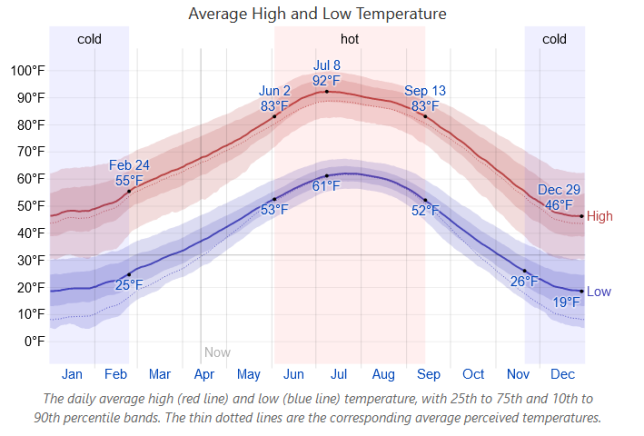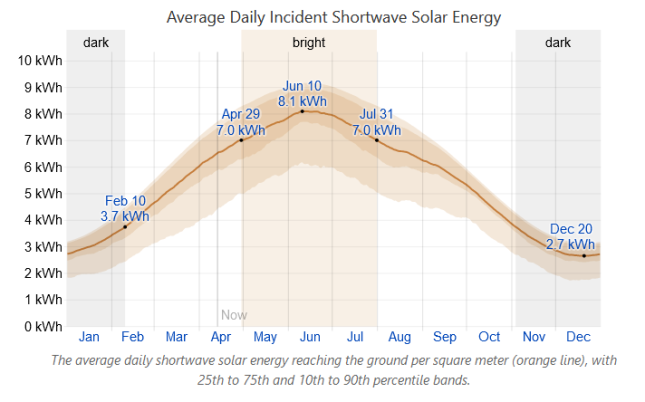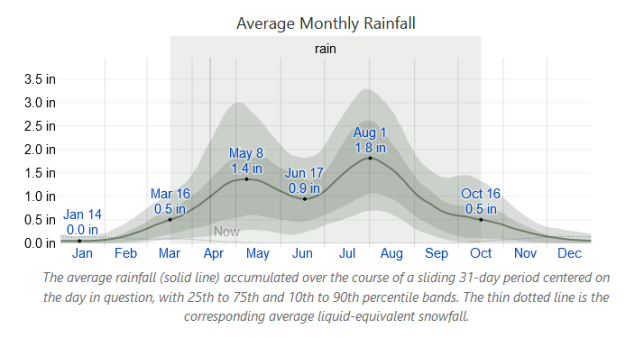So while we have the backbone of our calendar that was generated in the last post, you’ll note that many of these holidays lack any real direction for how to exactly celebrate them or participate in the natural shifts around you. This post and the next are here to help you flesh out your calendar by exploring ideas, themes, and associations you can link up with your holidays.
The backbone we made in the last post is meant to give you a basic framework to build around. From here, we’re going to utilize all of the information we still haven’t touched from the first post to refine what the yearly cycle in your area really looks like to you. It’s one thing to know when your summer starts and ends, or how much snow you get in the winter, but its another to know how these seasons actually play out where you live. Ideally, we will want to incorporate these elements into our yearly celebrations so that we’re genuinely connecting with the region we live in — not just a cardboard cutout that is generalized for ease of use.
Meeting Your Neighbors: Local Landforms
One of the first areas I wanted to start our layering process with is the concept of landforms. Landforms is a pretty generic term that encompasses pretty much every geological feature you’ve ever seen. This includes mountains, rock formations, lakes, valleys, etc. Taking stock of the landforms around you is essentially taking stock of the topography in which you live. Do you happen to live in a valley? on the edge of a valley? Are there any mountains nearby? Do you have any rivers or lakes that influence your area? What does the land look like where you live?
There are a couple of reasons why having this information can be useful, and which of these reasons applies to you will depend on what is most important to your individual practice.
Landforms Define Your Local Weather
First is that your local weather will be heavily influenced by the landforms closest to you. To use an example that is close to my heart, Phoenix, AZ is in the bottom of a valley that lies at the base of the Colorado Plateau. You’d think that since I’m an hour from Phoenix that my weather would be the exact same, but that’s not entirely true. I live on the southern ridge of this valley, on the north face of a series of small mountains. These mountainous landforms change the weather for me pretty dramatically. Being 600 feet higher in elevation means that my temperatures are often a few degrees cooler than Phoenix, and are about 5 degrees cooler than the closest town that is at the base of the mountains, about 20 minutes away.
Which is to say that looking at your local landforms will help to give you a better idea of how the weather works specifically where you’re at. Most of the weather information that you can pull will be from city centers and airports, and not all of us live in those specific locations where the weather data is pulled from. In order to tailor-fit your calendar, it’s best to observe whether landforms could be playing a role in your weather, and how that effects your yearly calendar.
Also keep in mind that man-made objects can also alter your weather, and if these structures are benefiting your weather patterns and systems, they may be worth incorporating into your calendar.
Landforms as Foci of Veneration
The second role that landforms can play in your calendar is to be a focus of veneration or adoration. For example, the mountain range that exists directly to the west and south of where I live often protects us from the worst monsoon storms. I have lived on both sides of what I call the “south ridge,” and I can attest that living south of this ridge means that your power will go out a lot more, and you’re more likely to have your house destroyed from the harsh weather that comes at us from across the dry river bed.
Knowing this means that I could always give thanks and attention to these mountains as we go into the monsoon season. Perhaps acknowledging that these mountains deflect the worst from us, and provide us with some amount of protection and stability in an inherently unstable season.
As another example, if you live near a large body of water, you may find that this body of water keeps your climate more temperate, as large lakes and oceans tend to take the edge off of the hottest and coldest parts of the year. Maybe you really love that your summer is nice and balmy, and would want to give thanks to this body of water for making that happen. This could involve having your celebrations at this body of water, or perhaps engaging in more direct action to protect or preserve it (whether through community action or volunteering to clean up the area, etc.)
From another angle, you may have learned that this large body of water serves as the main source of water for your local area. Knowing this, you may choose to incorporate this vital landform into your holidays, perhaps even creating a holiday that acknowledges your reliance on this water source existing. Some places where this might make sense would be in the springtime, as the snowpack begins to melt and begins to fill all of the waterways below, or to honor it during the summer, when your water supply is likely to be the most taxed for survival.
Nesting Local Ecology into Global Patterns
As you could potentially tell after reading about landforms, it becomes really easy to continue to shift the scope of your weather into a larger and bigger scale. The mountains that protect me come in contact with storm systems that are generated from the equator, and suddenly I’m looking at weather that’s happening in parts of the world I’ve never seen. To me, it helps to be able to place my local weather phenomena onto a larger scale to be able to see where my weather actually comes from, and by extension, to better understand what’s going on when my weather doesn’t behave as it normally does.
To use an example that’s familiar to some of my readership, in ancient Egypt, they knew that the inundation of the Nile was vital to their existence, but they didn’t have a full and solid understanding as to where that water actually came from. They believed it to bubble up out from the Duat in a cavern at the base of the river, but in truth, the answer is a lot more complicated and involves monsoon storms and snow packs in other parts of the continent. So in their frame of reference, you would cajole the deities that oversaw those caverns to ensure that you got enough water for the year. Where as under this model, you might cajole the monsoon rains to fall and the winter storms to bring a decent amount of snow so that there would be enough to fill your river later on.
This is also why I had you look into watershed maps. These maps will inform where your water comes from, and where you should focus your intent if you want to help ensure an appropriate amount of water comes to your area. For example, if you live somewhere whose water source relies on an aquifer being filled by a snow pack in a mountain range a few counties north of you, then it may be worth considering creating some sort of holiday that honors the role these mountains play in your survival.
Creating Associations
Part of fleshing out your calendar is having the ability to make associations between your holidays and the world around you. In this section, we’ll talk about a few ways to develop various associations in your area.
Seasonal Markers
Anything that helps to bring you to a particular time within the year would fall under this category. Put another way, these are the things that help you to notice that something is shifting around you. Usually, this would be seasonal shifts and changes, but it could also encompass other natural phenomena. Some examples of what these could be are:
- the first flowers that pop up in spring
- a particular type of wind that indicates that snow is coming
- migratory animals that are only in your region for brief periods of time throughout a given year
- the most-available natively-grown food item during your region’s “dead period” (most of you know it as winter)
- the first things that are edible in spring, or after the “dead period”
- the first leaves that change color during the fall
If you see it, and it lets you know that stuff around you is changing, it belongs in this category.
You could utilize these markers with the seasons they are associated with. For example, if you’re celebrating the beginning of a season, it might make sense to utilize the things that let you know this season is beginning in your holiday goings on.
Sustainers
The sustainer category is made up of anything that essentially helps to sustain your ecosystem in a particularly large way. These are essentially the keystone species that exist within your area, and would include both fauna and flora. This could also include landforms and larger ecological systems that help maintain the characteristics of your region such as a large reservoir that maintains the potable water for your area, or a particular forest that brings your seasonal rains down to where you live, or even a large tree that shades your porch in the summer.
In many ways, I would argue that this category would qualify as a sort of means of figuring out what is sacred in an area. Keystone species in particular leave a huge impact on the environment around them, so much that they are often used to gauge how healthy an ecological system is. When keystone species are removed from an ecosystem, the ecosystem is almost guaranteed to degrade and suffer until the balance is restored. As such, these species are worth protecting as much as possible, and to me, deserve sacred status where they natively occur.
Given that these species help to maintain the ecology of your region, I would argue that these species (or representations thereof, or potentially things associated with them) could be utilized in any holiday at any season. However, I also think there could be some potency in celebrating certain key times in the life cycle of the species within this category. For example, if there is a tree that is a keystone species, and it bears fruit, it might be worth celebrating when the fruit comes into season.
The Power of Observation
As a final note, we always say in permaculture that the most important skill that you can have is the skill of observation. Every year, I observe my surroundings, and every year, I discover new things. I notice new patterns that emerge, new ideas for holidays, new plant associations that form. By watching the world around you, and taking note of what you experience and when, you open up the possibility to incorporate an ever growing number of associations for your calendar.
For me, the calendar is about actively choosing to participate in the world around me. Sometimes, this means big displays of celebration or ritual. But sometimes, its nothing more than baring witness to what is going on around me. Not everything needs to be elaborate or large, and just by observing and paying attention, you are still participating in the natural patterns that occur around you. When we are not sure, or are lost on how to proceed, observation should be our fallback tool for coming up with new ideas and inspiration.
Hopefully this post has helped you to start thinking about ways you can begin to flesh out meaning and associations with your local natural settings. In the next post, we’ll discuss some ways in which religious practices can begin to be incorporated to your calendar.






